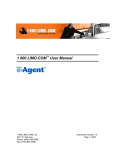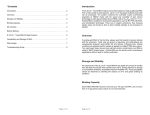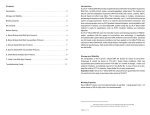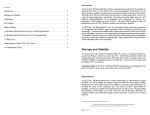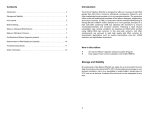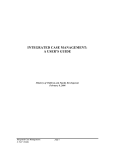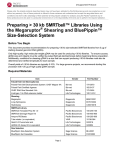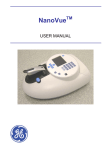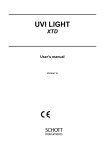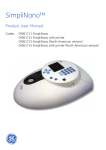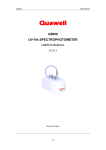Download Manual - Omega Bio-Tek
Transcript
Contents Introduction.. . . . . . . . . . . . . . . . . . . . . . . . . . . . . . . . . . . . . . . . . . . . . . . . . 2 New In This Edition. . . . . . . . . . . . . . . . . . . . . . . . . . . . . . . . . . . . . . . . . . . 2 Storage and Stability. . . . . . . . . . . . . . . . . . . . . . . . . . . . . . . . . . . . . . . . . . 2 Binding Capacity. . . . . . . . . . . . . . . . . . . . . . . . . . . . . . . . . . . . . . . . . . . . . 2 Kit Contents. . . . . . . . . . . . . . . . . . . . . . . . . . . . . . . . . . . . . . . . . . . . . . . . . 3 Before Starting. . . . . . . . . . . . . . . . . . . . . . . . . . . . . . . . . . . . . . . . . . . . . . . 3 W orking with RNA. . . . . . . . . . . . . . . . . . . . . . . . . . . . . . . . . . . . . . . . . . . . 3 Introduction The E.Z.N.A.® Plant RNA Midiprep Kit provides a convenient and rapid m ethod for the isolation of total RNA from a variety of plant sam ples. The kit includes shredding/hom ogenizing units to efficiently rem ove cell debris and sim ultaneously hom ogenize the lysate. In com bination with HiBind ® RNA spin colum ns, this perm its purification of high quality RNA from as m uch as 500 m g of tissue. Typical yields are shown in Table 1. E.Z.N.A.® Plant RNA Kits are ideal for processing m ultiple plant sam ples in less than one hour. The need for organic extractions is elim inated, m aking total RNA isolation fast, safe, and reliable. Purified RNA has Abs260/Abs280 ratios of 1.8-2.0 and is suitable for the following applications: ! ! ! ! RT-PCR Northern Analysis Differential display Poly A+ RNA selection E.Z.N.A.® Plant RNA Midiprep Protocol (standard protocol) . . . . . . . . . . . . 4 E.Z.N.A.® Plant RNA Midiprep Protocol for difficult samples. . . . . . . . . . . . 6 Yields obtained with E.Z.N.A.® Plant RNA Kits On Membrane DNase I Digestion . . . . . . . . . . . . . . . . . . . . . . . . . . . . . . . . 8 RNA Isolation from Arthropods.. . . . . . . . . . . . . . . . . . . . . . . . . . . . . . . . . . . . . 9 RNA Isolation from Fungal. . . . . . . . . . . . . . . . . . . . . . . . . . . . . . . . . . . . . . . . 10 RNA Quality. . . . . . . . . . . . . . . . . . . . . . . . . . . . . . . . . . . . . . . . . . . . . . . . 10 Arabidopsis sp 150 ìg Tobacco leaves 200 ìg Mustard leaves 150 ìg Maize 140 ìg Quantization and Storage of RNA . . . . . . . . . . . . . . . . . . . . . . . . . . . . . . . 10 Troubleshooting Guide. . . . . . . . . . . . . . . . . . . . . . . . . . . . . . . . . . . . . . . . 11 Ordering Information.. . . . . . . . . . . . . . . . . . . . . . . . . . . . . . . . . . . . . . . . . 12 Storage and Stability All components of the E.Z.N.A.® Plant RNA Kit should be stored at 22o C-25o C. Under these conditions, RNA has successfully been purified and used for RT-PCR after 24 months of storage. Under cool ambient conditions, a precipitate may form in the Buffer RB. In case of such an event, heat the bottle at 37o C to dissolve. Store Buffer RB at room temperature. Binding Capacity Each HiBind® RNA column can bind approximately100ìg of RNA. Using greater than 200 mg of plant tissue usually will not dramatically improve yields and sometimes has adverse effects. Page 2 of 12 Kit Contents Product No. E.Z.N.A.™ Plant RNA Protocol I (Standard Protocol) R6628-00 R6628-01 R6628-02 HiBind™ RNA columns 2 10 25 M aterials to be provided by user ! Swing Bucket centrifuge capable of 3,000-5,000 x g 15 ml Collection Tubes 4 20 50 ! Nuclease-free 15m l conical centrifuge tubes Homogenizer Midi Columns 2 10 25 ! 2-m ercaptoethanol ! Absolute (96%-100%) ethanol Buffer RPL 10 ml 40ml 100 ml ! Isopropyl alcohol (isopropanol) Buffer SP 2 ml 10 ml 20 ml ! Liquid nitrogen for freezing/disrupting sam ples Buffer RB 6 ml 30 ml 70 ml ! Preheat an aliquot (500 ìl per sam ple) of DEPC-treated water at 65 oC. RNA Wash Buffer I 10 ml 40 ml 90 ml RNA Wash Buffer II, Concentrate 5 ml 12 ml 50 ml 1.5 ml 20 ml 30 ml 1 1 1 NOTE : Use extreme caution when handling liquid nitrogen. DEPC-treated water User Manual This protocol is suitable for m ost fresh or frozen tissue sam ples allowing efficient recovery of RNA. However, due to the trem endous variation in water and polysaccharide content of plants, sam ple size should be lim ited to #500 m g. Best results are obtained with young leaves or needles. *B uffer R B contains a chaotropic salt. U se gloves and protective eye-ware when handling this solution. Note that all centrifugation steps m ust be carried out at room tem perature. Before Starting Please take a few minutes to read this booklet thoroughly to become familiar with the protocol. Prepare all materials required before starting to minimize RNA degradation. 1. W eigh up to 500mg of plant sample. Immediately place the weighed sample in liquid nitrogen, and grind thoroughly w ith a mortar and pestle. Decant the pow der and liquid nitrogen into an Rnase-free, liquid nitrogen cooled, 50ml centrifuge tube (not supplied). Allow the liquid nitrogen to evaporate, but do not allow the sample to thaw . 2. Immediately add 2.5ml of Buffer RB/2-mercaptoethanol. W e recom m end starting with 250 m g of tissue at first. If results obtained are satisfactory increase am ount of starting m aterial. Add 25ìl of 2m ercaptoethanol per 2.5 m l of Buffer RB. Sam ples should not be allow ed to thaw before Buffer RB/2-mercaptoethanol is added. Vortex vigorously to m ake sure that all of the clum ps are dispersed. RNA cannot be effectively extracted from clum ped tissue. Dilute Wash Buffer II with absolute ethanol as follows IMPORTANT R6628-00 Add 20m l 100 % ethanol R6628-01 Add 48 m l 100 % ethanol R6628-02 Add 200 m l 100% ethanol Working with RNA . ! Whenever working with RNA, always wear latex gloves to minimize RNase contamination. Change gloves frequently. Use only clean RNase-free disposable plastic pipette tips when using the supplied reagents. ! During the procedure work carefully but quickly. ! Under cool ambient conditions, crystals may form in Buffer RB. This is normal and the bottle may be warmed to redissolve the salt. ! 2-mercaptoethanol (ß-mercaptoethanol) is key in denaturing endogenous RNases and must be added to an aliquot of Buffer RB and Buffer RPL before use. Add 20ìl of 2-mercaptoethanol per 1 ml of Buffer RB or RPL. This mixture can be stored for 1 week at room tem perature. TIP: As a guide, a 2-cm diam eter leaf square weighs approxim ately 100 m g 3. Transfer the lysate directly into a Homogenization M idi-Spin Column placed in the collection tube. Centrifuge at 3,000-5,000 x g for 15 minutes at room temperature. 4. Carefully transfer the supernatant of the flow -through fraction to a new 15 ml centrifuge tube, making sure not to disturb the pellet Page 4 of 12 5. or transfer any debris. Add 0.5 volume of absolute ethanol and mix by vortexing. E.Z.N.A.™ Plant RNA Midi Protocol II (for difficult samples) TIP: In m ost cases 2.0 m l supernatant can easily be rem oved. This will require 1.0 m l ethanol. Note that depending on the sam ple, the volum e of supernatant m ay vary. After transferring to a fresh tube, m easure the volum e and add the correct am ount of ethanol. Certain plant samples are very difficult for RNA isolation because of amount of material and type of secondary metabolites. This method involves a simple and rapid precipitation step for removal of much of the polysaccharides and phenolic compounds commonly found in plant tissues. Use this protocol when standard protocol did not yield RNA or got low er yield. Apply the entire sample, including any precipitates that m ay form to a HiBind® RNA M idi-Spin column assem bled in a 15.0 m l collecting tube (supplied). Centrifuge at 3,000-5,000 x g for 5 m inutes at room tem perature. Discard the flow-through liquid and place the colum n back into the collection tube. 1. Optional on-membrane DNase I digestion: This is the starting point to perform DNase I digestion. See Page 8 for detailed protocol. 6. 7. Add 3.5 ml RNA W ash Buffer I. Centrifuge at 3,000-5,000 x g for 5 minutes. Discard the flow-through liquid and place the colum n back into the collection tube. Grind plant sample as described on page 4. Collect frozen ground plant tissue (up to 500 mg) in a microfuge tube and immediately add 3.5ml of Buffer RPL/2-mercaptoethanol. W e recom m end starting with 250 m g of tissue at first. If results obtained are satisfactory increase am ount of starting m aterial. Add 20ìl of 2m ercaptoethanol per 1m l of Buffer RPL. Samples should not be allow ed to thaw before Buffer RPL/2-mercaptoethanol is added. Vortex vigorously to m ake sure that all of the clum ps are dispersed. RNA cannot be effectively extracted from clum ped tissue. Note: Add 20ìl of 2-mercaptoethanol per 1 ml of Buffer RPL before use. This m ixture can be m ade and stored at room tem perature for 1 week. Add 3.5ml W ash Buffer II diluted w ith ethanol. Centrifuge at 3,0005,000 x g for 2 m inutes at room tem perature. Then discard the flowthrough and place the colum n back into the collection tube. 2. Add 700ìl of Buffer SP and vortex thoroughly to mix. Centrifuge at 3,000-5,000 x g for 20 minutes at room temperature. Note: W ash Buffer II Concentrate m ust be diluted with absolute ethanol before use. Refer to the label on the bottle for directions. 3. Carefully aspirate cleared lysate to a RNase-free 15ml centrifuge tube making sure not to disturb the pellet or transfer any debris. Add one volume of isopropanol and vortex to precipitate RNA. This step removes much of the polysaccharide content and improves spin-column performance by increasing RNA binding capacity (and therefore yield) in the steps that follow. No incubation is required after addition of isopropanol. 8. W ash column w ith a second 3.5ml of W ash Buffer II by repeating previous step. Centrifuge and discard the flow-through. 9. Then with the collection tube em pty, centrifuge the Midi-spin colum n for 10 min at 3,000-5,000 x g to com pletely dry the HiBind™ m atrix. 11. Elution of RNA. Transfer the column to a new RNase-free 15 ml centrifuge tube (not supplied) and elute the RNA w ith 500ìl of DEPC-treated w ater (supplied). Make sure to add water directly onto colum n m atrix. Centrifuge at 3,000-5,000 x g for 5 m inutes. A second elution into the sam e tube m ay be necessary if the expected yield of RNA >300 ìg. Note: RNA m ay be eluted with a greater volum e of water. W hile additional elutions increase total RNA yield, the concentration will be lowered since m ore than 80% of RNA is recovered with the first elution. No RNA extraction procedure can com pletely rem ove genom ic DNA. For sensitive work (such as RT-PCR or differential display) we suggest that you treat the eluted RNA with RNase-free DNase. Also for RT-PCR, use intron-spanning prim ers that allow easy identification of DNAcontam ination. TIP: In most cases 3.5 ml supernatant can easily be removed. This will require 3.5 ml isopropanol. Note that depending on the sample, the volume of supernatant may vary. After transferring to a fresh tube, measure the volume and add the correct amount of isopropanol. 4. Immediately centrifuge at 3,000-5,000 x g for 20 min at room temperature to pellet RNA. A longer centrifugation does not improve yields. 5. Carefully aspirate or decant the supernatant and discard making sure not to dislodge the RNA pellet. Invert the microfuge tube on a paper towel for 5 min to allow residual liquid to drain. Drying the pellet is not necessary. 6. Add 500ìl of RB buffer pre-heated to 65oC and vortex to resuspend the pellet. A brief incubation at 65o C may be necessary to effectively dissolve the RNA. 7. Add 1.25ml of Buffer RB/2-mercaptoethanol followed by 1.75ml of 70% ethanol. Vortex thoroughly to mix. This will adjust binding conditions prior to loading the HiBind® RNA column. Page 6 of 12 8. 1. DNase I is very sensitive and prone to physical denaturing; so do not vortex the DNase I mixture. Mix gently by inverting the tube. Prepare the fresh DNase I digestion mixture before RNA isolation. Apply the entire sample, including any precipitates that may form to an HiBind® RNA Midi-spin column assembled in a clean 15 ml collection tube (supplied). Centrifuge at 3,000-5,000 x g for 5 minutes at room temperature. Discard the flow-through liquid and place the column back into the collection tube 2. OBI DNase I digestion buffer is supplied with OBI RNase-free Dnase set. Note: This is the starting point to perform DNase I digestion. See page 8 for detail protocol. 9. Add 3.5ml of RNA Wash Buffer I and centrifuge at 3,000-5,000 x g for 5 minutes. Discard the flow-through liquid and place the column back into the collection tube. 10. Add 3.5 ml of Wash Buffer II diluted with ethanol. Centrifuge at 3,0005,000 x g for 30 seconds at room temperature. Discard the flow-through and place the column back into the collection tube. 11. Wash the column with a second 3.5 ml of Wash Buffer II as in previous step. Centrifuge and discard the flow-through. 12. Then with the collection tube empty, centrifuge the Midi-spin column at 3,0005,000 x g for 10 minutes to completely dry the HiBind™ matrix. 13. Elution of RNA. Transfer the column to a RNase-free 15 ml microfuge tube (not supplied) and elute the RNA with 500ìl of DEPC-treated water (supplied). Make sure to add water directly onto column matrix. Centrifuge at 6000 x g for 5 minutes at room temperature. A second elution into the same tube may be necessary if the expected yield of RNA >300 ìg. 3. Standard DNase buffers are not compatible with on-membrane Dnase digestion. B. Pipet 375 ìl of the DNase I digestion reaction mix directly onto the surface of the HiBind® RNA matrix in each column. Make sure to pipet the Dnase I digestion mixture directly onto the membrane. Dnase I digestion will not be complete if some of the mix sticks to the wall or the O-ring of the HiBind® RNA column. C. Incubate at room temperature(25-30NC) for 15 minutes 2. Place column into a clean 15.0ml collection tube, and add 3ml of RNA W ash Buffer I. Incubate for 5 minutes at room temperature. Centrifuge at 6000 x g for 2 minutes and discard the flow-through. Reuse the collection tube. 3. Place the column into the same 15ml collection tube, and add 3.5ml of RNA W ash Buffer II diluted with ethanol. Centrifuge at 3,000-5,000 x g for 5 minutes and discard the flow-through. Reuse the collection tube. Note: Wash Buffer II Concentrate must be diluted with absolute ethanol before use. Refer to label on bottle for directions. 4. DNase digestion Protocol (Optional) Since HiBind® RNA resin and spin-column technology actually removes most of DNA without the DNase treatment, it is not necessary to do DNase digestion for most downstream applications. However, certain sensitive RNA applications might require further DNA removal. The following steps provide on-membrane DNase I digestion: (see DNase I, Cat # E1091 for further information). 1. Follow the standard protocol until the samples have completely passed through the HiBind® RNA column. Prepare the following: A. Pipet 1.5ml of RNA Wash Buffer I into the HiBind® RNA Midi-spin column, and centrifuge at 3,000-5,000 x g for 5 minutes to wash the column. Discard the flow through. For each HiBind® RNA Midi-spin column, prepare the DNase I digestion reaction mix as follows: OBI DNase I Digestion Buffer 367.5 ìl RNase-free DNase I (20 Kunitz unites/ìl) 7.5 ìl Total volume 375 ìl W ash column with a second 3.5 ml of W ash Buffer II by repeating step 3. Centrifuge and discard the flow-through. 5. Then with the collection tube empty, centrifuge the Midi-spin column at 3,0005,000 x g for 10 minutes at full speed to completely dry the HiBind® matrix. 6..Elution of RNA. Transfer the column to a clean 15 ml microfuge tube (not supplied) and elute the RNA with 50-100 ìl of DEPC-treated water (supplied). Make sure to add water directly onto the column matrix. Centrifuge for 1 minute at maximum speed. A second elution may be necessary if the expected yield of RNA >50 ìg. Alternatively, RNA may be eluted with a greater volume of water. W hile additional elutions increase total RNA yield, the concentration will be lowered since more than 80% of RNA is recovered with the first elution. Preheating the water to 70o C before adding to column and incubating column for 5 minutes at room temperature before centrifugation may increase yields. RNA Isolation from Arthropods The exoskeleton of arthropods poses the sam e problem s as encountered with m any plant specim ens. Pigm ents and polysaccharides often co-purify with nucleic acids and interfere with downstream applications. Note: Page 8 of 12 Prepare all necessary m aterials and reagents (listed on page 4) and follow the procedure below: 1. Freeze and grind up to 500 m g of arthropod tissue under liquid nitrogen. Grind tissue com pletely to obtain a fine hom ogenous powder. 2. Immediately add 2.5 ml of Buffer RB/2-mercaptoethanol. Add 20ìl of 2-m ercaptoethanol per 1m l of Buffer RB and then add 2.5 m l of this m ixture to the sam ple. Samples should not be allow ed to thaw before Buffer RB/2-mercaptoethanol is added. Vortex vigorously to m ake sure that all clum ps are dispersed. RNA cannot be effectively extracted from clum ped tissue. RNA Quality It is highly recommended that RNA quality be determined prior to all analyses. The quality of RNA can be assessed by denaturing agarose gel electrophoresis and ethidium bromide staining. Several sharp bands should appear on the gel. These are the 28S and 18S ribosomal RNA bands as well as certain populations of mRNA and possibly viral RNA bands. If these bands smear towards lower molecular weight RNAs, then the RNA has undergone major degradation during preparation, handling, or storage. RNA molecules less than 200 bases in length do not efficiently bind the HiBind matrix, thus the method enriches high quality RNA. Since no RNA extraction procedure can completely remove genomic DNA. For sensitive work (such as RTPCR or differential display) either on-membrane DNase I digestion treatment or after elution DNase I digestion will be needed. For modified protocols for DNase I digestion, call our technical staff at 800.832.8896 for assistance Note: Add 20ìl of 2-mercaptoethanol per 1 ml of Buffer RB before use. This m ixture can be m ade and stored at room tem perature for 1 week. 3. Proceed with the Plant RNA Midi prep Protocol from step 3 (page 4). RNA Isolation from Fungi E.Z.N.A.® Plant RNA Kit can also be used for fungal RNA isolation since m any fungal sam ples possess sim ilar cellular attributes as m any plant specim ens. 1. Freeze and grind up to 500 m g of fungal sam ple under liquid nitrogen. Grind tissue com pletely to obtain a fine hom ogenous powder. 2. Immediately add 2.5 ml Buffer RB/2-mercaptoethanol. Add 10ìl of 2m ercaptoethanol per 1m l of Buffer RB and then add 2.5m l of this m ixture to the sam ple. Samples should not be allowed to thaw before Buffer RB/2-mercaptoethanol is added. Vortex vigorously to m ake sure that all of the clum ps are dispersed. RNA cannot be effectively extracted from clum ped tissue. 3. Proceed with the Plant RNA Protocol from step 3 (page 4). Quantization and Storage of RNA To determine the concentration and purity of RNA, measure absorbancy at 260 nm and 280 nm in a spectrophotometer. 1 O.D. unit measured at 260 nm corresponds to 40 ìg of RNA per ml. The ratio of A 260/A 280 of pure nucleic acids is 2.0, while for pure protein it is approximately 0.6. A ratio of 1.8-2.0 corresponds to 90%-100% pure nucleic acid. (Phenol has an absorbancy maximum at 275 nm and can interfere with spectrophotometric analysis of DNA or RNA. However, the E.Z.N.A.® Plant RNA Kit eliminates the use of phenol and avoids this problem.) Store RNA samples at -70oC in water. Under such conditions RNA prepared with the E.Z.N.A. system is stable for more than a year. Page 10 of 12 Troubleshooting Guide Ordering Information Problem Cause Suggestion Little or no RNA eluted RNA remains on the column ! ! ! Clogged column Precipitated RNA will not dissolve. Repeat elution. Pre-heat DEPC-water to 70o C prior to elution. Incubate column for 10 min with water prior to centrifugation. Column is overloaded ! Reduce the quantity of starting material. Incomplete disruption or lysis of plant tissue. ! Completely disrupt sample in liquid nitrogen. Increase centrifugation time. Reduce amount of starting material High nucleic acid and polysaccharide content. ! Source ! ! ! ! Reduce the amount of starting material. Generally it is best to start with 50-100 mg at first. To avoid RNA degradation, do not increase incubation time for resuspension. P roduct N um ber P roduct N am e D escription E .Z.N .A.™ Total R N A M iniprep K its R 6634-01/02 R 6834-01/02 E .Z.N .A .™ T otal R N A K it Total R N A isolation from anim al cells or tissues. R 6614-01/02 R 6814-01/02 E .Z.N .A .™ B lood R N A K it Total R N A Isolation from blood sam ples R 6627-01/02 R 6827-01/02 E .Z.N .A .™ P lant R N A K it Total R N A Isolation from plant sam ples R 6640-01/02 R 6840-01/02 E .Z.N .A .™ Fungal R N A K it Total R N A Isolation from fungal sam ples R 6670-01/02 R 6870-01/02 E .Z.N .A .™ Yeast R N A K it Total R N A Isolation from yeast sam ples R 6850-01/02 R 6950-01/02 E .Z.N .A .™ B acterial R N A K it Total R N A Isolation from yeast sam ples R 6675-01/02 R 6875-01/02 E .Z.N .A .™ Mollusc R N A K it Total R N A Isolation from m ollusc, invertebrates sam ples. E .Z.N .A.™ Total R N A M idi/m axi K its Degraded RNA ! ! ! RNase contamination ! ! Problem in downstream applications Salt carry-over during elution ! ! ! Freeze starting material quickly in liquid nitrogen and store at -70o C without thawing. Follow protocol closely, and work quickly. Make sure that 2-mercaptoethanol is added to Buffer RPL. Use RB Buffer as dissolvent instead of DEPC water. Ensure not to introduce RNase during the procedure. Check buffers for RNase contamination. Ensure Wash Buffer II has been diluted with 100% ethanol as indicated on bottle. Diluted Wash Buffer II must be stored at room temperature. Repeat wash with Wash Buffer II. DNA contamination Co-purification of DNA ! Digest with RNase-free DNase and inactivate at 75o C for 5 min. Low Abs ratios RNA diluted in acidic buffer or water ! DEPC-treated water is acidic and can dramatically lower Abs260 values. Use TE buffer (pH 8) to dilute RNA prior to spec analysis. R 6664-01/02 E .Z.N .A .™ T otal R N A M idi K it Total R N A isolation from anim al cells or tissues R 6693-01/02 E .Z.N .A .™ T otal R N A M axi K it Total R N A isolation from anim al cells or tissues R 6615-01/02 E .Z.N .A .™ B lood R N A Midi K it Total R N A isolation from blood sam ples R 6616-01/02 E .Z.N .A .™ B lood R N A Maxi K it Total R N A isolation from blood sam ples R 6628-01/02 E .Z.N .A .™ P lant R N A M idi K it Total R N A isolation from plant sam ples O ther R N A isolation kit, R eagent and supplies R 6511-01/02 m R N A E nrichm ent k it m R N A isolation R 6830-01/02 R N A -S olv™ reagent S ingle reagent for total R N A isolation R 6248-01/02 R 6249-01/02 E .Z.N .A .™ R N A P robe purification k it R N A P robe purification R 6376-01/02 E .Z.N .A .™ P oly-G el R N A Isolation K it Isolate R N A from poly-acrylam ide gel R 6500-01/02 E .Z.N .A .™ O ligo (dT ) C ellulose H igh capacity oligo(dT ) cellulose E 1091 R N ase-free D N ase I set D N ase I set for on-colum n D N ase digestion Page 12 of 12






